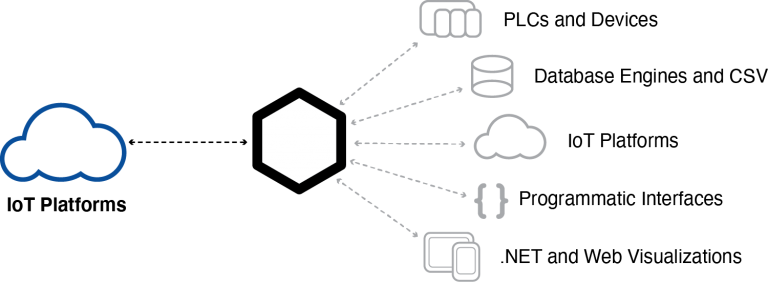Your Bridge to Azure IoT Hub
It doesn’t matter what the data source is – with Open Automation Software you can move it to Azure IoT Data Hub and Azure Event Hubs.
With OAS, integrating with Azure IoT Hub and Azure Event Hub IoT is seamless, ensuring secure, accurate, and fast data transfer. Timestamp verification via the Advanced Message Queuing Protocol (AMQP) keeps your data intact. Use live local, remote, or plant floor data to power big data analytics in Azure IoT Hub.
- Send live data directly to Azure IoT devices with the built-in AMQP protocol driver.
- Maximize the potential of Azure's big data and IoT services.
Production data
Down time monitoring
Weather Data
Alarm Data
Supply chain information
BMS (Building Management Systems)
Energy monitoring
Inventory data
OEE (Overall equipment effectiveness)
Maintenance data
GPS Data
Well Production
a server-based, highly-scalable, network platform that enables the transport and transformation of your data
Data HistorianAchieve fault-tolerant logging, zero data loss, and multi-destination storage with our high-performance Store and Forward technology.
Visualization ToolsBuild Visualizations, User Interfaces, and server configuration interfaces for .NET, web technologies, native iOS and Android mobile apps
Device & Data ConnectorsThe OAS Platform provides rapid communications and connectivity to a wide variety of PLCs, devices, and databases.
IoT ConnectorsConnect to cloud-base IoT gateways such as AWS, Azure IoT Hub, Azure Event Hubs, Kafka, and more.
Alarm Logging & NotificationCapture events on each data point, log to open formats for historical analysis and archiving, and trigger real time notifications
SDKs & APIsExplore a wide variety of Developer Tools and APIs to allow you to create applications and system integrations to execute in any environment.
Networking FeaturesOpen Automation Software implements edge computing with a Distributed Network Architecture.
Download a fully functional trial of Open Automation SoftwareKey Features & Benefits
Industry 4.0 Data Sources
Modbus, Allen Bradley PLCs, Siemens S7 Controllers, OPC UA, OPC DA, MQTT, Sparkplug B, MTConnect, AWS IoT Core, Kafka, .NET, REST Clients, Databases
Efficient Remote Device Communication with AMQP
The OAS Azure IoT Hub gateway uses AMQP, a lightweight protocol designed for resource-limited devices. It enables low-bandwidth, reliable data transfer, even with intermittent connections, and supports bidirectional communication.
Event Based Publishing with Store and Forward
Publish data to Azure IoT devices based on event, continuously, or data change. Include timestamp and data quality from originating source. Enable Store and Forward option to buffer data during service interruptions.
Live Data In Azure Services
Publish data to Azure IoT Hub and Azure Event Hubs in a JSON payload containing multiple values, qualities, and timestamps with 100 nanosecond resolution. Take full advantage of any or all of the other services provided by Azure.
JSON Handling
OAS effortlessly parses and constructs JSON packets with your chosen data—all without requiring any coding.
Data Accuracy & Reliablity
Data from each data source is processed on-premise in a first-in, first-out (FIFO) manner. This ensures that all data received from the broker is preserved and not just the latest value.
Easy Azure IoT Hub Integration & Data Publishing
The OAS Azure IoT Connector simplifies publishing to Azure IoT Hub and AMQP Azure Event Hub using structured JSON with values, timestamps, and quality indicators.
The AMQP interface enables direct publishing to Azure IoT devices, supporting event-driven, continuous, and change-based data transmission.
Store and Forward
Store and Forward ensures uninterrupted data flow during service interruptions, leveraging AMQP Azure Event Hub for seamless connectivity.
Optionally enable the Store and Forward property in the Azure IoT driver interface to buffer data to disk in the event of communication loss to the Azure server. This maintains 100% data in case of network failure.

Common Use Cases
What data sources can OAS connect to my Azure IoT hub?
OAS connects to a variety of data sources, including PLCs, databases, and OPC servers, making it easy to integrate real-time data with your Azure IoT Data hub and Azure Events Hub.
Retain Data on Network Failure
In the OAS driver interface, enable the Store and Forward property. When this property is enabled, data will be stored on disk during network outages to Azure and from remote OAS Edge nodes.
Learn how thousands of customers are using the OAS Product Platform around the globe to achieve truly open industrial automation
24/7/365
Support
Technical support available by phone, chat, and email
30+ Years
Experience
Product efficacy, market testing, and reliability
Used in 10K+
Data Servers
OAS is used in thousands of businesses worldwide
OAS Platform Features
Cross-Platform Support
The OAS Platform supports multiple operating systems and deployment options including Windows, Linux, Docker Containers, and can even run on low footprint devices such as a Raspberry PI 4.
Networking
OAS is an edge solution that offers flexible networking options for standalone installations, multi-tenant data aggregation, and even secure unidirectional data transport.
Programmatic Setup
Utilize our .NET SDK or REST API for flexible and automated setup, ensuring full integration with your asset management software. You can also import and export CSV files, which helps you work with Excel and third-party applications.
Calculations, Time On, Counts, and Totals
Merge data from various controllers and additional data sources while performing real-time computations and logic processing, all without the need for coding. Monitor the duration of activities for specific points and the frequency of their transitions over a defined period. Aggregate analog values both daily and over the entire timeline.
See How We Compare
The initial cost of OAS is far less than our competitors – but the savings don’t stop there. We work with OEMS and System Integrators to provide perpetual licenses with quantity discounts with flexible tag pricing and unlimited client connections.
No Questions Left Unanswered
We make getting started with OAS easy - Browse our extensive Knowledge Base of articles on Getting Started as well as How To content that takes you step-by-step through building a solution, and finally learn more about specific features and configurations.
Get Started with Open Automation Software
Get Started with Azure IoT Data Hub
Step-by-step introduction to using the Open Automation Software platform
An overview of publishing data to Azure IoT Data Hub.
Getting Started Azure Event Hubs
Guided steps and video how to publish data to Azure IoT Data Hub.
An overview of publishing data to Azure Event Hubs.
Guided steps and video how to publish data to Azure Event Hubs.
How to use OAS JavaScript Object Notation payload parsing and construction features.





